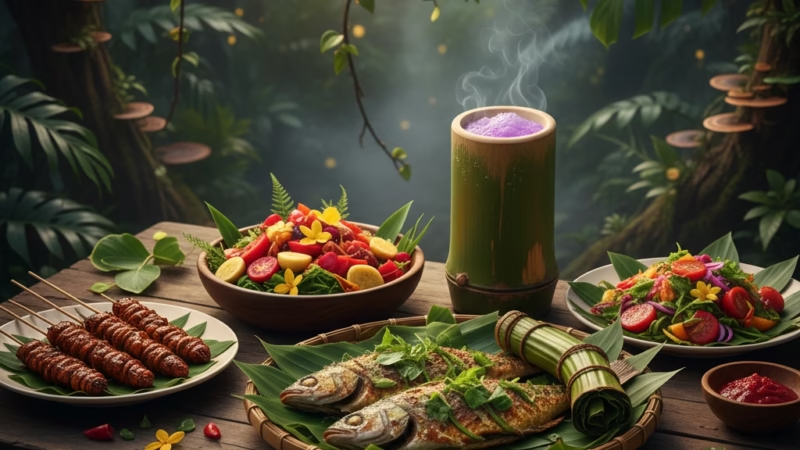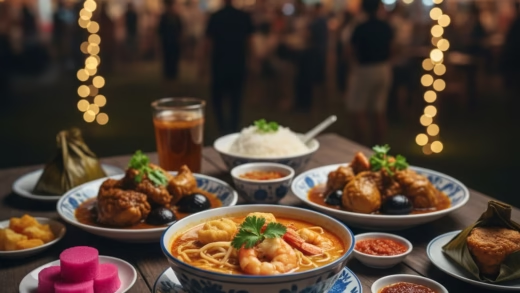Exotic Jungle Food

Malaysian Food
Exotic Jungle Food
Origin
Found in tropical rainforests and remote jungle regions worldwide, including Southeast Asia, South America, and Central Africa.
Category
Wild, foraged, and traditional foods; includes fruits, nuts, roots, insects, wild game, and freshwater fish.
Appearance
Varies widely: bright-colored fruits, mushrooms with unique shapes, roots and tubers, insects, small reptiles, and game meat. Often rustic and unprocessed.
Ingredients
- Wild fruits: durian, rambutan, mangosteen, wild berries
- Edible plants: ferns, bamboo shoots, tubers
- Protein sources: insects (grasshoppers, ants), small mammals, birds, fish
- Herbs and spices: native leaves, seeds, and bark
Preparation
- Roasting over open fire
- Boiling in leaves or clay
- Fermentation (for fruits or seeds)
- Drying or smoking meats
- Minimal seasoning, often just salt or natural herbs
Equipment
- Machetes, knives, stones
- Cooking pits or open fire
- Leaves for wrapping and steaming
Variations
- Region-specific: Amazon uses manioc, African jungles favor termites and bushmeat, Southeast Asia offers wild ferns and exotic fruits.
- Raw, cooked, smoked, or fermented versions of ingredients.
Taste
Varies from bitter or earthy (roots and tubers), sweet (fruits), umami (game meats), to nutty or spicy (insects and seeds).
Texture
Crunchy (insects, nuts), chewy (tubers, meats), juicy (fruits), fibrous (wild vegetables).
Aroma
Earthy and smoky from cooking fires; sweet-fragrant fruits; musky or gamey scents from meat.
Sound
Crackling of fire; crunch of roasted insects or nuts; bubbling when boiling food in leaves.
Cultural Significance
Vital part of indigenous diets; connects communities to ancestral knowledge and survival skills; used in rituals or traditional medicine.
Symbolism
Represents self-sufficiency, harmony with nature, and ancestral heritage.
Regional Cuisine
- South American Amazonian tribes
- Southeast Asian Orang Asli and Dayak communities
- Central African jungle communities
Social Context
- Gathered collectively by communities
- Hunting and foraging often gendered or ritualized
- Celebratory feasts include rare jungle delicacies
Nutritional Information
- High in protein (insects, game)
- Rich in vitamins and minerals (wild fruits and tubers)
- Fiber-rich (leaves, roots, fruits)
Health Benefits
Boosts immunity; provides essential amino acids and micronutrients; some plants and seeds have medicinal properties.
Dietary Restrictions
- Potential allergens: certain nuts, insects
- Not suitable for strict vegan diets if meat or insects are consumed
Allergens
Nuts, seeds, shellfish-like insects, certain fungi
Cost
- Minimal monetary cost in jungle communities (foraged locally)
- Expensive if sourced commercially due to rarity and transport
Production
- Wild foraging, hunting, and fishing
- Sustainable in small-scale traditional settings
- Can impact biodiversity if over-harvested
Sustainability
Typically sustainable if practiced traditionally; overharvesting and deforestation threaten availability.
Availability
- Fresh in jungles year-round, depending on season
- Rare in urban markets unless specially sourced
History
Staple diet for indigenous people for millennia; knowledge of edible and medicinal plants passed orally.
Anecdotes
Some jungle tribes survive entirely off foraged foods for months during migration or hunting season; adventurers often seek jungle food experiences for authenticity.
How to Prepare
- Identify edible plants, fruits, and proteins.
- Clean thoroughly to remove dirt or toxins.
- Cook over open fire, boil in leaves, or smoke meats.
- Pair with locally found herbs or fermented condiments.
FAQ
Q: Is all jungle food safe to eat?
A: No; proper knowledge of edible plants and insects is essential to avoid toxins.
Q: Can exotic jungle foods be eaten in urban areas?
A: Some fruits and meats can be transported, but live foraged insects and fresh game are harder to access.
Q: Are jungle foods nutritious?
A: Yes, they are nutrient-dense, but some can be bitter or tough and require careful preparation.





Comments are closed.